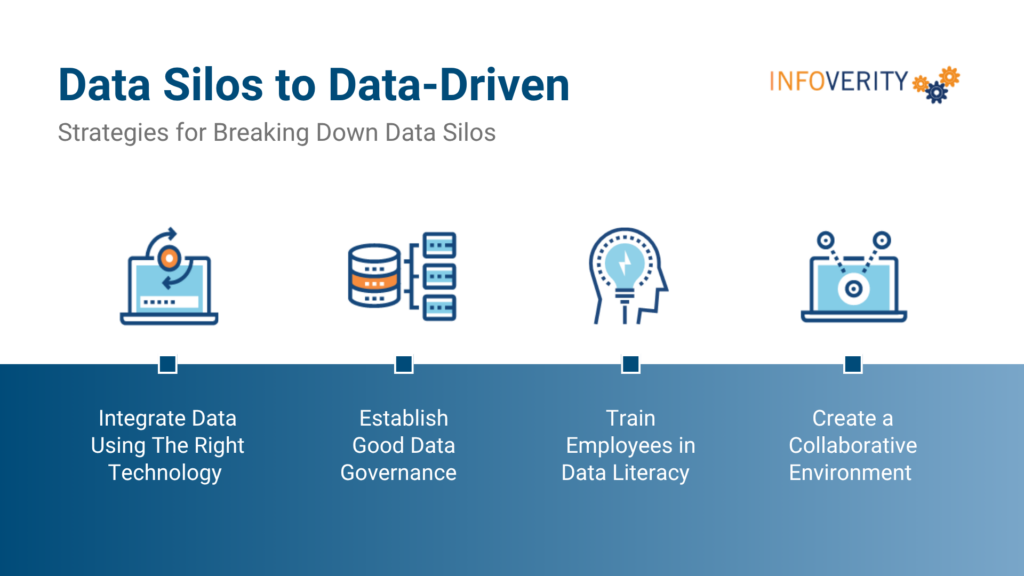Different departments, tools, and data sets. The result is data silos.
Data silos emerge when one team collects data sets that others can’t access or analyze when needed. Therefore, it creates barriers to an organization’s understanding of its business activities and performance, which could eventually mire collaboration, communication, and strategic planning.
As businesses introduce new technology to their systems, data silos are more likely to arise. More than 40% of surveyed organizations have struggled with this. The persistence of data silos has impeded their efforts to become data-driven.
In this article, we’ll touch on the repercussions of siloed data and how to resolve them.

No time to read? – Skip the scroll and absorb the insights hands-free. This post is part of Infoverity’s Audio Blog Archive — built for busy professionals like you.
Data silos: Table of Contents
Why Data Silos Are A Problem
Modern businesses do typically have a big technology stack.
To illustrate: Sales teams rely on a CRM. The marketing department uses a marketing automation tool. Meanwhile inventory managers have their ERP, the customer service representatives leverage an incident management system. Thus, each tool has a purpose.
But, what these tools don’t do is connect the information they have at the backend. They don’t develop a unified perspective that all departments can share and benefit from.
For instance, CRM tools generate insights, such as purchase history, that could help various departments do better strategic planning.
Marketing teams can tailor messages and product promotions in their email campaigns. Inventory managers can stock up on the frequently purchased items. The customer service department can also use past purchase info for prompt issue resolution.
This type of cooperative working environment is hampered by data silos. Siloed organizations deal with data that can’t be shared, accessed, or integrated across departments. As a result, companies suffer from:
Organizational Division
Because data is confined to the system or the department managing it, the organization, as a whole, lacks visibility into data that can help them make informed decisions and identify growth opportunities or risks.
Statistics
68% of knowledge workers reported that information bottlenecks have negatively impacted their work. These bottlenecks make discovering cover cross-functional insights and opportunities that can improve processes, customer experiences, and product development difficult – if not impossible.
Poor Data Quality
In a fragmented environment, finding incomplete, inconsistent, and overlapping data sets is not surprising. In fact, This poor data quality weakens the data’s credibility and leads to errors in analysis and reporting. Worse yet, bad data can set enterprises back an average of US$12.9million.
Process Inefficiency
Data silos cause employees to lose 30% of their weekly work hours chasing data. Without access to integrated data, they need to manually piece together information from different systems or departments to arrive at a decision or resolve a problem.
As a result, production managers can end up spending hours manually collecting data from inventory, quality control, and production tracking systems just to prepare a weekly performance report. This inefficiency is time-consuming and a error-prone.
Security and Compliance Risks
A 2024 report showed that 70% of organizations operating with data silos suffered a breach within the past 24 months. This is because compartmentalized data makes coordinating efforts to tighten security posture and resolve incidents difficult for security teams. Furthermore, using isolated systems to store sensitive information also poses a compliance risk.
Looking to become a data-driven organization?
Infoverity can help your business remove information barriers and build a data-driven organization. To discover more on how we can help you address data silos and achieve your objectives 
Key Strategies for Breaking Down Data Silos
Data silos are the biggest obstacle companies face when it comes to becoming data-driven. Fortunately, dismantling them only requires both technological and organizational solutions to work in tandem.

Integrating Data Using The Right Technology
The lack of interconnectivity in an organization’s tech stack is the primary cause of data silos – especially if the company runs on outdated or customized systems.
Uprooting these systems is a costly endeavor. However, a workaround exists in the form of data integration. It involves collecting data and housing them in a single source of truth, such as a data warehouse or a data lake.
Data integration tools, such as ETL (Extract, Transform, Load) and ELT (Extract, Load, Transform), and APIs allow frictionless information exchange between different applications and systems.
To support this interconnectivity, master data management (MDM) solutions are necessary to establish clean, accurate, and reliable data throughout the organization. This connectivity is especially important when handling critical data elements, such as customer information and product information.
Once the tools are in place, enterprises need to regularly monitor data integration efforts and performance metrics to pinpoint weaknesses and strengthen their tools and processes.
Establish Good Data Governance
In an organization’s pursuit of removing data silos, the first step is to set up a good data governance framework. In addition, the framework should define a set of procedures, policies, and personnel that outlines how an organization should retrieve, store, search, and employ data.
Like data integration and data management, establishing data governance is a continuous undertaking. It’s a long-term commitment that can become challenging with changes in the business environment and leadership.
Train Employees in Data Literacy
Enterprises can prevent knowledge lockdowns by teaching non-tech employees how data is linked to their jobs.
According to Jordan Marrow, VP and Head of Analytics of software adoption tool BrainStorm: “Data literacy begins with 3 key components–curiosity, creativity, and critical thinking. Motivating employees to become data literate is an organizational responsibility”.
Companies can run a skills-gap test and ask for feedback to figure out how they can help business users and frontline workers leverage data. Thus, these insights are necessary for creating a successful data literacy program.
Create a Collaborative Environment
Organizations can facilitate a collaborative culture by focusing on interdisciplinary projects, knowledge sharing, and cross-functional collaboration. For example, this can be done by setting up interdepartmental meetings that allow different teams to exchange ideas and share information.
From the backend, management should align incentives and key performance indicators (KPIs) to promote shared goals, rewarding behaviors that encourage data sharing and collaboration. Moreover, celebrating cross-functional accomplishments through awards and public acknowledgement can reinforce this information-sharing culture.
These four strategies aren’t exhaustive, but they provide a good starting point. At Infoverity, we believe organizations should start small and scale slowly. Keeping integration efforts focused on specific use cases or departments at the beginning allows the initiative to yield the best results. Once efforts prove successful, only then can the organization slowly spread out its integration initiatives.
Organizations Don’t Need to Spiral in Siloed Data
The lack of sharing or access between departments and systems within an organization leads to data silos. But the right combination of processes, tools, and people can knock them down. Thus, allowing every department to make the most out of the available enterprise data.
Enable better decision-making and reduce wasted resources. Work with Infoverity to remove these information barriers and build a data-driven organization. Reach out to us today.
FAQs – Data Silos
What are data silos?
Data silos emerge when one team collects data sets that others can’t access or analyze when needed. It thereby creates barriers to an organization’s understanding of its business activities and performance.
What problems cause data silos?
Data silos lead to Organizational Division (teams lack visibility, slowing decisions and collaboration), Poor Data Quality (incomplete, inconsistent data weakens accuracy and trust), Process Inefficiency (employees waste time manually chasing disconnected information) and Security & Compliance Risks (silos increase the risk of breaches and regulatory penalties).
Why data silos are a problem?
Modern businesses do typically have a big technology stack. But what these tools don't do is connect the information they have at the backend. They don’t develop a unified perspective that all departments can share and benefit from. This type of cooperative working environment is hampered by data silos.
How to fix siloed data?
Data silos are the biggest obstacle companies face when it comes to becoming data-driven. The lack of sharing or access between departments and systems within an organization leads to fragmented data. But the right combination of processes, tools, and people can knock them down, allowing every department to make the most out of the available enterprise data.



